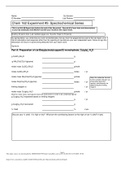Chem 162 experiment 5 - Guides d'étude, Notes de cours & Résumés
Vous recherchez les meilleurs guides d'étude, notes d'étude et résumés sur Chem 162 experiment 5 ? Sur cette page, vous trouverez 22 documents pour vous aider à réviser pour Chem 162 experiment 5.
Page 3 sur 22 résultats
Trier par

-
Chem 162 Experiment #5
- Autre • 4 pages • 2023
-
 DrPhilip
DrPhilip
-
- $8.49
- + en savoir plus
Part A: Preparation of cis-Bis(glycinato)copper(II) monohydrate, Cu(gly)2·H2O g CuSO4·5H2O g g NH2CH2CO2H (glycine) g molar mass CuSO4·5H2O g/mole moles CuSO4·5H2O moles 1 pt molar mass NH2CH2CO2H (glycine) g/mole moles NH2CH2CO2H (glycine) moles 1 pt limiting reagent is 1 pt molar mass Cu(gly)2·H2O g/mole 1 pt (Note for molar mass: each glycine loses the acidic proton in order to be a bidentate ligand) g Cu(gly)2·H2O expected based on limiting reagent g 1 pt g Cu(gly)2·H2O reco...
CHEM 162 Experiment #5: Spectrochemical Series

Ce résumé que vous venez d'acheter a fait très plaisir à quelqu'un. Vous voulez aussi être payé chaque semaine ? Vendez vos documents d'étude sur Stuvia ! Découvrez tout sur gagner de l'argent sur Stuvia



